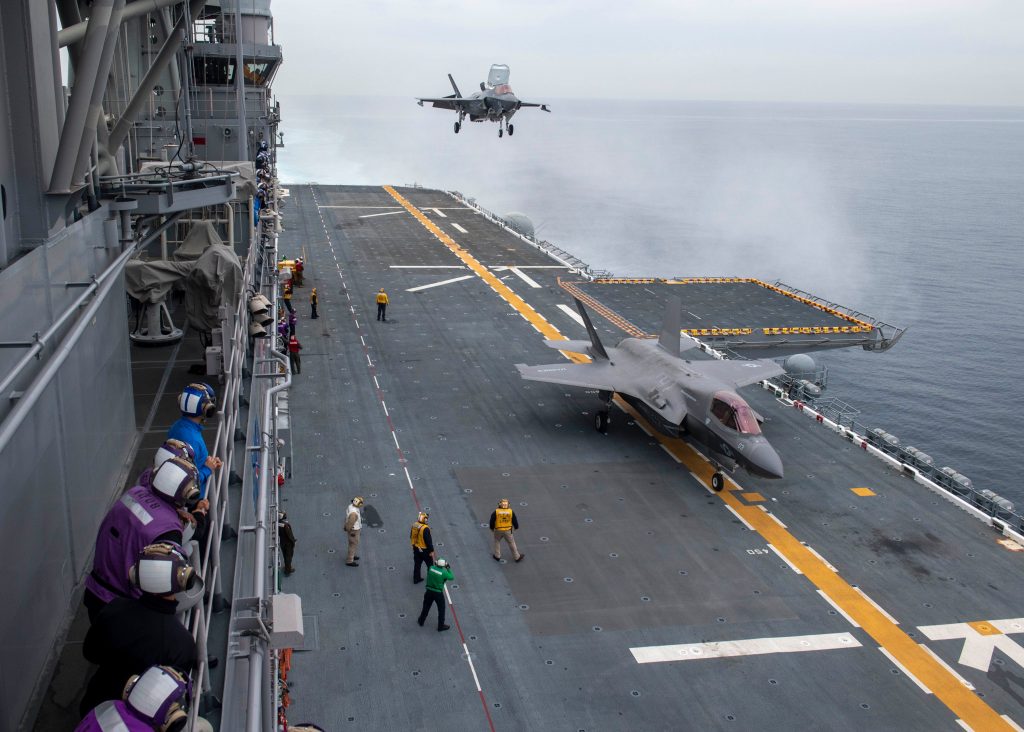[ Forbes ] It’s Official: After A 75-Year Gap, The Japanese Navy Has An Aircraft Carrier
On Sunday, a pair of U.S. Marine Corps F-35B jump jets from the Japan-based Marine Fighter Attack Squadron 242 landed on, then launched from, the Japanese carrier JS Izumo.
The proof-of-concept comes just months after the 813-foot Izumo, which the Japanese built as a helicopter carrier, completed the first of two rounds of modification—so far costing around $30 million—for embarking fixed-wing planes. Izumo’s sister ship Kaga is undergoing her own, similar modification in one go, starting this year.

JS Izumo. Photo: Twitter@PacificMarines
The stealth jump jets launched along the port side of Izumo’s deck, carefully avoiding the self-defense gun that’s still fixed to the carrier’s bow. Modifications the Japanese navy plans to start in 2024 should move the gun in order to free up more of Izumo’s deck for flight ops.
“This trial has proved that the JS Izumo has the capability to support takeoffs and landings of [short-takeoff, vertical-landing] aircraft at sea, which will allow us to provide an additional option for air-defense in the Pacific Ocean in the near future,” said Japanese navy rear admiral Shukaku Komuta, commander of Escort Flotilla One.
The return of big-deck aviation to the Japanese fleet comes just in time. The western Pacific is getting more dangerous by the day as China continues its massive military build-up.
As it rushes to qualify its new carriers for front-line operations, the Japanese fleet had little choice but to invite U.S. Marine jets aboard Izumo. The Japanese air force is acquiring 42 F-35Bs to operate from Izumo and Kaga, but the first of the jump jets isn’t due to arrive in Japan until 2023.


Partnering with the Marines allows the Japanese navy to train deck crews and work out procedures in advance of Japan’s own F-35Bs entering service.
It’s worth noting that the U.S. Marine Corps, which with more than 100 F-35Bs is the biggest operator of the radar-evading jump jet, is helping other allied navies work up their own new carriers.
Marine jets embarked on the new Royal Navy flattop HMS Queen Elizabeth for her ongoing inaugural cruise, which saw the 919-foot carrier sailing south of Taiwan around the same time Izumo was landing F-35Bs for the first time.
This spring, Marine F-35Bs also briefly operated from the Italian navy carrier ITS Cavour off the Virginia coast in order to verify upgrades allowing that vessel to operate Italy’s own F-35Bs.
The Japanese navy long has operated helicopter carriers. It was a small but politically significant step when, in 2018, Tokyo approved the Izumo and Kaga’s conversions into carriers of winged aircraft.
The two new flattops have an obvious place in Japan’s naval strategy. In a war with China, the Japanese fleet would aim to blockade the Chinese fleet from breaking out of the China Seas via a northern route and entering the wider Pacific Ocean.
A chain of island outposts stretching from Japan to Taiwan would anchor the blockade. Heavily-armed naval task forces would plug the gaps between the islands. Carriers embarking F-35Bs would protect the task forces and add to their long-range firepower.
DPA Notes: It was never a surprise to anyone that Izumo and Kaga were designed and built for the sole purpose of turning them into F-35 carriers…
It was extremely obvious from the outset due to its flat top design but awkwardly classified as a destroyer.

